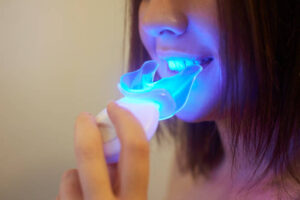
A Look into the Effectiveness and Safety of At-Home Whitening Devices
Bright, white smiles are more popular than ever, and many people are turning to LED whitening kits as a convenient, at-home solution. Promising professional-level results without a trip to the dentist, these kits have flooded the market — but are they truly safe and effective? Before you invest in a whitening kit, it’s important to understand both the benefits and the potential risks.
What Are LED Whitening Kits?
LED whitening kits typically combine a bleaching agent — usually hydrogen peroxide or carbamide peroxide — with an LED light that activates the whitening process. The LED light is thought to speed up the chemical reaction, helping to break down stains more quickly. While many users report seeing noticeable improvements after just a few uses, not all kits are created equal, and improper use can lead to unwanted side effects.
Key Points to Consider:
-
Effectiveness Varies by Product and User:
-
Some kits deliver noticeable results in a short time, but effectiveness depends on the strength of the bleaching agent, the quality of the device, and the user’s original tooth color.
-
-
Potential Risks to Gums and Enamel:
-
Overuse or incorrect application can cause gum irritation, tooth sensitivity, and even enamel erosion if the product is too harsh or left on too long.
-
-
Professional Supervision is Safer:
-
Consulting with a dentist before using any whitening kit can help prevent complications and ensure you choose a product that’s safe for your specific dental needs.
-
Weighing the Pros and Cons
The biggest advantage of at-home LED kits is convenience. You can whiten your teeth on your own schedule, often at a lower cost than professional treatments. Many users find these kits helpful for maintaining a bright smile between dental visits. However, the risks shouldn’t be ignored. Some people experience increased tooth sensitivity after using at-home kits, and without professional guidance, there’s a higher chance of misuse.
It’s also important to recognize that not all stains respond well to whitening treatments. For example, discoloration caused by medications or internal tooth damage may not improve significantly with at-home kits. In these cases, professional treatments or alternative cosmetic options might be more effective.
Final Thoughts: Safe Use Matters
LED whitening kits can be a safe and effective option — but only when used properly. Always follow the instructions carefully, and be cautious about using products with very high concentrations of bleaching agents. If you have sensitive teeth, gum disease, or extensive dental work (like crowns or veneers), it’s especially important to speak with a dentist first.
In conclusion, at-home LED whitening kits offer a convenient way to enhance your smile, but they come with potential risks if not used correctly. For the best (and safest) results, choose reputable products, stick to recommended usage guidelines, and don’t hesitate to involve your dentist in your whitening journey.

0 Comments